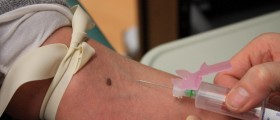What is Fibroadenoma?
Fibroadenoma is a solid, benign tumor of the breast. It occurs during the reproductive period of a woman. Fibroadenomas are smooth and either rubbery or hard lumps. They are not attached to the skin and can move when palpated.
The size of these tumors ranges from one to several centimeters, and they can enlarge during pregnancy and lactation. These tumors never turn into malignant and most commonly are only monitored. In some cases, fibroadenomas are surgically removed.
Symptoms of Fibroadenomas
These tumors can be easily palpated, and if they are bigger, a woman may feel them just by touching the breast. Some fibroadenomas are placed deep under and are harder to be palpated. Since nowadays majority of women are aware of breast cancer and its early detection, they most commonly find the tumor if they perform regular palpatory exams. The lump is, in most cases, round and firm and resembles a marble. It can be easily moved, and it is not attached to the skin or the surrounding tissue.

Fibroadenomas are painless lumps. However, in some women, especially during menstruation, fibroadenomas may become more sensitive and cause mild pain in the affected breast.
A woman may have one or more fibroadenomas. The tumor can be rather small, and some of them can reach 5 cm or more in length. In this case, fibroadenomas are classified as giant fibroadenomas.
Simple fibroadenomas cannot turn into malignant tumors. On the other side, complex fibroadenomas, apart from fibro glandular tissue contain cysts, enlarged breast lobules, and calcifications. These fibroadenomas also cannot convert into malignant, but they increase the general risk of later development of breast carcinoma.
Every woman who has palpated a lump in her breast needs to see a doctor as soon as possible. Only the doctor can perform certain examinations and confirm or rule out the diagnosis of fibroadenoma. The woman should not hesitate and feel embarrassed to consult a doctor since painful lumps can also be breast carcinoma. The sooner the correct diagnosis is established, the better the outcome of the disease.
Diagnosis of Fibroadenomas
The doctor will examine the patient. Namely, a clinical breast exam includes the palpation of both breasts. The doctor will also ask several questions related to the newly found lump.
Young women, especially those that have not been pregnant and are planning a family, will then be examined by ultrasound of the breasts. If the results of the ultrasound are ambiguous, the woman will have to be examined by mammography.
The best way to confirm or rule out the diagnosis of fibroadenoma or malignant tumors of the breast is achieved by mammography. This examination is for women older than 30 and those who are at higher risk of developing breast cancer.
If necessary, the doctor will also perform fine-needle aspiration, and the obtained fluid and cells will be pathophysiologically examined. And finally, a core biopsy is performed on some solid breast tumors to rule out the possibility of a malignant tumor.
- This research was conducted at Nanfang Hospital, Guangzhou, Guangdong, China.
- A total of 11?898?women aged 18–40 years who underwent breast screening between 1 January 2019 and 31 December 2019 were included in the fibroadenoma prevalence study. From 1 June 2019 to 31 December 2019, 342 breast lesions with pathology reports and preoperative ultrasound images were collected for diagnostic fibroadenoma testing (vs histological diagnostic testing).
- Of the women aged 18–40 years, 27.6% (3285/11 898) had an ultrasound diagnosis offibroadenoma. Of these, the prevalence of fibroadenoma was stable across age groups (p=0.14) and did not differ between the left and right sides of the breast. Almost two-thirds of women presented with a single fibroadenoma, and most fibroadenomas did not exceed 1?cm in size. The sensitivity and specificity for fibroadenoma were 97.0% (95% CI for sensitivity: 93.7% to 98.8%) and 91.4% (95% CI for specificity: 85.4% to 95.5%) for ultrasonography, respectively.
- The study population was from a single medical centre in Guangzhou city, however, the size and the diversity of the population compensate for this limitation to a great extent.
- Some participants in this study might have undergone breast screening owing to having specific symptoms, this might have increased the prevalence of fibroadenoma in the study population.
- As the study was performed only on healthy women who underwent physical examination, a large-scale screening study is required to evaluate an asymptomatic population and predict the prevalence of breast fibroadenoma.
- The study’s findings might not be generalisable to older age groups and geographical regions outside China.

















Your thoughts on this
Loading...